


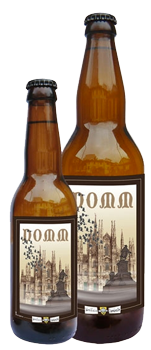

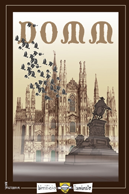
5.2%
Origin:
Disposable Kegs: TBA
From July 2013
Ale in Bavarian HefeWeizen style. Opalescent, as appropriate to the style, it’s characterised by the classic straw yellow. On the nose, it features marked banana, clove and fresh notes, followed by an herbaceous taste of hopper in the final. In the mouth, the banana fruity and the interesting citrus tastes prevail, leaving to the beer an unexpected dry note which fades into a light bitterish taste.
FACT: The beer got its name from Milan Cathedral ('Domm' in Milanese dialect), the symbol of the city. [Milanese] El Domm de Milan l'è la gesa pussee granda de Milan, e la se troeuva in mezz a la Piazza del Domm, in del center de la cittaa. L'è vunna di costruziun gotich pussee famos e pussee grand del mond.El Domm l'è dedicaa a Santa Maria Nascent, e ona statoa d'or de la Madonna (ciamada La Madonnina) la stà in scima a la gulia pussee alta del Domm. [Italian] Milan Cathedral is the biggest church of Milan, situated in Cathedral Square in the centre of the city. Dedicated to Saint Mary of the Nativity, whose golden statue (called Madonnina) is placed at the top of the highest spire of the Cathedral, it remains one of the most famous and greatest gothic buildings in the world.
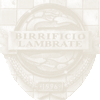
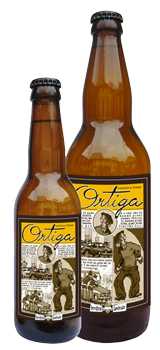

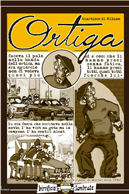
5%
Origin:
Disposable Kegs: TBA
July 2013

Ale in English Golden Ale style. Orange-coppery in colour, it’s slightly opaque once poured into the classic pint. On the nose, a subtle caramel accompanies the herbal, resinous and spicy-citrus notes of the hoppers. Light-bodied, in the mouth it’s clean and has a pleasurable bitter final which undoubtedly makes it a dangerous drinkable.
FACT: Ortica (Ortiga in Milanese dialect) is one of the quarters of Milan that once was a hamlet of Lambrate city which later became a part of Milan in 1923. The name comes from 'a garden', a place for growing vegetables and easily irrigated by the River Lambro. From the end of the 1800s till 1931 there used to be an old Lambrate station, a building mostly for travellers but also for other uses. The Ortica quarter became popular thanks to a renowned singer and a songwriter Walter Valdi in the song 'The Pole', which was later performed by Enzo Jannacci. The song, a reminder of 'Big Deal on Madonna Street', is about a rebellious band of thieves, who decide to make one of their members a pole who is supposed to divert anyone's attention to let the band do their job. Unfortunetely, the pole almost could not see or hear. [Milanese]«Faceva il palo nella banda dell'Ortica, ma l’era sguercio, el ghe vedeva quasi pù: e l’è staa inscì che i hann ciapaa senza fadiga, i hann ciapaa tutt, ma propi tutt, foeura che lù.» [Italian] 'He was the pole in the band of the Garden but almost could not see, and so it was that took them without difficulty, took them all, most of them, all out of him'. (W.Valdi: The Pole)

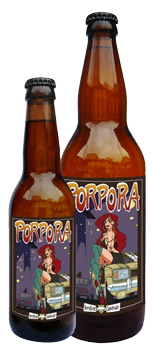

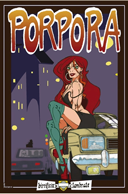
7.8%
Origin:
Disposable Kegs: TBA
From July 2013

Lager in the Hopped Bock style. Bright red colour with ruby reflections. On the nose, caramel notes are neat and followed by clear herb notes from hoppers, finally surmounted by winy and dried fruit scents. It tastes of syruped fruit but it never becomes sickly, thanks to the perfect balance ensured by the hopper. As a whole, this beer has an extraordinary balance which makes it extremely easy to drink.
FACT - As well as being the colour of this beer, luminous red with ruby glints, it is also the name of the nearby Porpora Street – the proper landmark of Lambrate quarter. After World War II the street became famous for high concentration of harlots who, in order to attract potential clients, would walk along the pavements of the quarter near their hotels or apartments or would sit on straw chairs. What is more, the street was named after the opera composer and singing teacher Nicola Antonio Porpora (1686-1768), whose pupils were the world's greatest talents of the XVIII century. One of the most renowned was Carlo Broschi known as Il Farinelli.
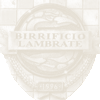
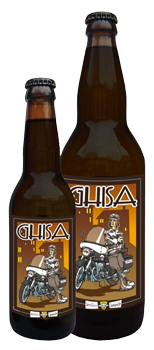

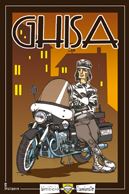
5%
Origin:
Disposable Kegs: TBA
From July 2013

Ale in Smoked Stout style. With an interesting colour of a friar’s frock, this beer is characterised by a thick cappuccino-coloured foam. On the nose, it has smoked notes recalling scamorza and toasting notes recalling coffee. In the mouth, it’s more delicate and features notes of liquorice, cocoa and dried fruit (carob) which come along with a delicate bitter taste due to the toasting of malts.
FACT: Even today in Milan one can hear 'El ghisa', a friendly way the citizens still call traffic officers. Lots of theories try to find out and explain the origins of this nickname: some claim that it comes from an old black uniform worn by the officers that reminded of the colour of cast iron fountains, whereas others think that it was named after the cast iron coat of arms that the officers wore on their helmets. Anyway, the most convincing theory has reference to top hats worn by the officers in 1860. The hats looked like cast iron tubes of some stoves at that time or eaves tubes (in dialect called 'canon de stua').



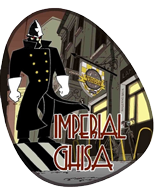
8.5%
Origin:
From July 2013

Lager in the Smoked Baltic Porter style. Impenetrable. Black in colour. On the nose, this extreme version of the Ghisa features toasting, coffee grounds, smoking, bitter cocoa and toffee notes, and a winy alcoholic component which accompanies the fragrance of alcohol soaked redberries. In the mouth, it’s full bodied and corresponds to the sensations felt in the nose. Meditative warming beer, the alcoholic impact is not as violent as expected.













































